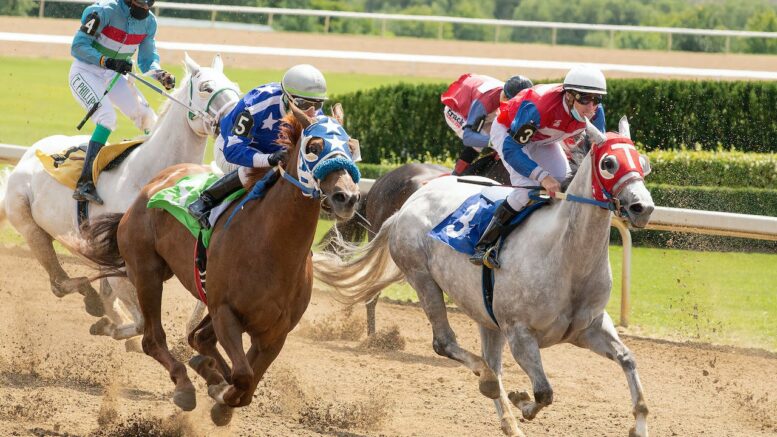The life of a horse jockey carries significant risks of being injured, and sometimes, even to die. Running on horses that could reach significant speeds all while sitting on a very precarious position, exposes them to severe damage whenever they fall or impact with something during a race.
To minimize these risks, jockeys employ several strategies available, but what really matters is the quality of the personal protective equipment (PPE) worn by them. Because, in the end, no matter how hard you try to prevent accidents from occurring, they still happen from time to time. What makes the difference is how robust are the precautions you took to protect your body from harm.
The hard job of a jockey and the risks they face every day
Jockeys sit atop incredibly fast horses who run in tracks in turf and dirt. The animals weight about 1,000 pounds, run at speeds of up to 40 mph (60 Km/h), while a jockey is usually a small guy weighting less than 120 pounds wearing only a helmet, a pair of glasses, and a safety jacket. If that wasn’t enough already, jockeys must ride in a very precarious position to minimize the effect of their weight on the horse’s momentum and top speed. This position, known as “Martini Glass” force them to ride with very short stirrups to raise their center of gravity above the animal’s shoulders, using a saddle that is sensibly smaller, and comparably less safe, than those used by other riders. The less falls a rider has, the more likely they are to be selected to ride the best horses in prestigious races such as the Kentucky Derby. Esteemed jockey Jose Ortiz will ride Locked in this year’s event, he’s had 2,000+ career wins and only fallen a handful of times so the Kentucky Derby odds are suggesting he’ll be the man to beat.
This kind of ride can be very thrilling for audiences, but also extremely risky for the jockey. Pitch-perfect balance is required to maintain this perched and crouched position, but in case of falls, this same position leaves very little room for minimizing the impact with the ground or other horses. On top of all that, since they all run very close to each other, when an accident occurs, multiple horses can fall at same time. This exposes their riders to the serious risk of being trampled or crushed by a 1,000 pounds beast thrown at full speed.
Common types of injuries suffered by horse jockeys
The most common type of injury suffered by jockeys is a soft-tissue injury, such as a cut, bruise, skin damage, pulled muscle, torn tendon, or sprained limb. Hard-tissue injuries are also very common, and they generally pose a higher threat to the jockey’s health. These injuries include broken bones, dislocated joints, loss of teeth and concussions. This last one in particular, is especially dangerous, since the rider may not be immediately aware of the injury. Symptoms such as confusion, memory loss, nausea and vomit may require some time to appear, and even more time to heal.
According to a study, nearly half (41%) of the injuries suffered by jockeys occurs at the starting gate area – either at the beginning of the race, or at the end. The vast majority of the injuries, almost 75% of them, result from the rider being thrown from the horse. Since falls occur on average every 4.6 race days, it’s easy to measure how frequently jockeys end facing the consequences of an injury.
Personal Protective Equipment (PPE) worn by jockeys
The PPE worn by jockeys consists of several different pieces, each one serving a different purpose. Here is a list:
- Vest: The vest is one of the most important parts of the safety equipment worn by jockeys since it provides an overall robust and reliable protection during falls. Vests cushion the jockey when he falls, and minimize the impact thanks to the padding in the chest and ribs. Since 1998, vests are mandatory to wear during races.
- Helmet: The most vulnerable part of a human being in case of a fall is the head. That’s why helmets are worn by all racers, including F1 and Grand Prix pilots. Jockeys’ heads are similarly at risk, so helmets and skullcaps are mandatory and can really make the difference between life and death. Covers are generally worn over helmets to represent the jockey’s colors in that race.
- Skivvy and Racing Pants: A skivvy is a light and comfortable shirt made of mesh or microfiber. Racing pants are similarly made from very elastic materials. Skivvies and pants protect the upper and lower body, respectively. Light and stretchable, they’re both worn to reduce the risk of bruises, abrasions and cuts, and to reduce friction with the saddle or with nearby horses. However, they are not padded, so they can’t do much to reduce impact damage.
- Gloves: Jockey don’t wear reinforced gloves like Grand Prix riders since they need precision and sensitivity to maneuver their horses. However, their gloves still proved them protection from friction and bad weather, and improve their grips.
- Glasses: During a race, something hitting a jockey’ eyes can cause them to lose concentration, or, even worse, lose their balance and fall. To prevent that, jockeys wear horse racing goggles that protect them from accidental collisions with dirt, bugs, or gravel.
Conclusion
Jockey are always at risk of injury during races. To minimize their risk they wear several pieces of PPE, but more importantly, train themselves a lot to avoid falling during a ride.
